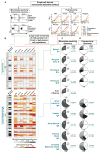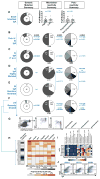Natural polyreactive IgA antibodies coat the intestinal microbiota
- PMID: 28971969
- PMCID: PMC5790183
- DOI: 10.1126/science.aan6619
Natural polyreactive IgA antibodies coat the intestinal microbiota
Abstract
Large quantities of immunoglobulin A (IgA) are constitutively secreted by intestinal plasma cells to coat and contain the commensal microbiota, yet the specificity of these antibodies remains elusive. Here we profiled the reactivities of single murine IgA plasma cells by cloning and characterizing large numbers of monoclonal antibodies. IgAs were not specific to individual bacterial taxa but rather polyreactive, with broad reactivity to a diverse, but defined, subset of microbiota. These antibodies arose at low frequencies among naïve B cells and were selected into the IgA repertoire upon recirculation in Peyer's patches. This selection process occurred independent of microbiota or dietary antigens. Furthermore, although some IgAs acquired somatic mutations, these did not substantially influence their reactivity. These findings reveal an endogenous mechanism driving homeostatic production of polyreactive IgAs with innate specificity to microbiota.
Copyright © 2017 The Authors, some rights reserved; exclusive licensee American Association for the Advancement of Science. No claim to original U.S. Government Works.
Figures





References
-
- Honda K, Littman DR. The microbiota in adaptive immune homeostasis and disease. Nature. 2016;535:75–84. - PubMed
-
- Macpherson AJ, Uhr T. Induction of protective IgA by intestinal dendritic cells carrying commensal bacteria. Science. 2004;303:1662–1665. - PubMed
-
- Macpherson AJ, et al. A primitive T cell-independent mechanism of intestinal mucosal IgA responses to commensal bacteria. Science. 2000;288:2222–2226. - PubMed
Publication types
MeSH terms
Substances
Grants and funding
- F30 AI124476/AI/NIAID NIH HHS/United States
- P30 DK042086/DK/NIDDK NIH HHS/United States
- R01 HL118092/HL/NHLBI NIH HHS/United States
- R37 AI038339/AI/NIAID NIH HHS/United States
- U19 AI057266/AI/NIAID NIH HHS/United States
- T32 GM007281/GM/NIGMS NIH HHS/United States
- U19 AI109946/AI/NIAID NIH HHS/United States
- R01 GM106173/GM/NIGMS NIH HHS/United States
- T32 AI007090/AI/NIAID NIH HHS/United States
- U01 AI125250/AI/NIAID NIH HHS/United States
- P41 GM103694/GM/NIGMS NIH HHS/United States
- R01 AI108643/AI/NIAID NIH HHS/United States
- R01 AI038339/AI/NIAID NIH HHS/United States
- U19 AI082724/AI/NIAID NIH HHS/United States
LinkOut - more resources
Full Text Sources
Other Literature Sources
Miscellaneous

